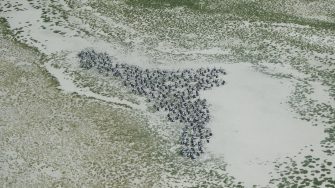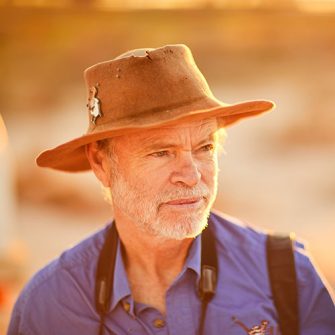
Date: Tuesday November 7th 2023
Project: Eastern Australian Waterbird Survey
Observers: Richard Kingsford (UNSW), Jody O'Connor (SA DEW)
Pilot: Thomas Clark
We headed off west of Moree, beginning with a flight down the Gwydir River where The Raft, as it is called has built up over the years, with logs that now block some of the flow of the river. Last year's floods have exacerbated the problem.
Surveying the Gwydir River near Moree
The Raft makes it increasingly difficult to move water, including environmental flows, down the river to the wetlands at the bottom of the river, without flooding landholders along the way. This is one of the big issues in the Murray-Darling Basin: the constraints on delivery of environmental flows.
Surveying some of the drying lagoons along the Gwydir River
This was our second count along the Gwydir River and Gingham watercourse, again surveying the areas that we did yesterday. So, there were no surprises. But it is always interesting to see the numbers and diversity over a couple of days.
Small flooded areas along the Gwydir wetlands
There weren't as many Brolgas but the Black Duck were still there and, it was great also to see a Black-necked Stork or Jabiru.
Surveying along the Gwydir wetlands, most of which were dry
From here we headed West to Narran Lakes. This was a treat. Narran Lakes is at the bottom of the Narran River which comes off the Condamine-Balonnne River from Queensland.
There was a no water in Clear Lake which is in the Narran Lakes Nature Reserve
The massive Narran Lake was spectacular. When you see sights like this with so many waterbirds, it's invigorating. It's also hard work counting. There were thousands of pelicans, including a small colony. But there were also Freckled Duck, Glossy Ibis, probably about 50 Brolgas, about a thousand migratory birds, migratory species from the Northern Hemisphere.
Surveying Narran Lake and its thousands of waterbirds
Narran Lake also had lots of different duck species, mainly Grey Teal but also Black Duck and Pink-eared Ducks. But there were also the three species of ibis including Straw-necked Ibis, Glossy Ibis and Australian White Ibis. There were plenty of spoonbills, Masked Lapwings and thousands of Whiskered Terns. It was a wonderful sight.
Thousands of waterbirds were all along the edge of Narran Lake
Small colony of breeding pelicans, Narran Lake
There were thousands of pelicans on the lake, including the small colony. This system is obviously on the way out and this is nowhere more obvious that some of the signs of weak and dying pelicans. Not sure how well the colony is going to go with the lake drying so quickly.
Thousands of feeding pelicans
Incredible numbers of pelicans across the lake
Once we had finished, we headed south to Bourke over the Darling River. After refuelling us and the plane, we headed to the Paroo River lakes, northwest. This is the outer reaches of the western part of the Murray-Darling Basin. These are the rivers that are largely unregulated. They are still going through their natural cycles of booms and busts. But there's no doubt that climate change is impacting increasing evaporation rates.
Yantabulla Swamp was dry, a wetland that receives water from the Warrego river and the Cuttaburra Channel mainly, but also from the Paroo River. It's a magnificent wetland, when it has lots of water.
Then it was on to the Currawinya Lakes. I have long worked on these. They are among my favourites in inland Australia. They can have tens up to hundreds of thousands of waterbirds at times. When we did the surveys in the late 80s, there were sometimes hundreds of thousands of waterbirds on lakes.
Dry Lake Wyara which is a salt lake and Lake Numalla which is mostly freshwater, make up the Currawinya Lakes, forming a national park
The two lakes have quite a different ecology, if you want to read about it here's our paper. But today Lake Wyara was dry. And Lake Numalla was probably only about 70% full.
Drying back Lake Numalla
Surveying Lake Numalla, one of the Currawinya Lakes
The lake had thousands of waterbirds. There were huge flocks of pelicans and Grey Teal and many other species including Hardhead, Silver Gulls as well as Black Ducks and Pink-eared Ducks.
Surveying the large numbers of waterbirds on Lake Numalla
There were even three small colonies of pelicans, sitting on nests on the southern part of the lake.
There were three small colonies of pelicans on Lake Numalla
This was uplifting. It is one of the privileges of this survey to see these amazing numbers of waterbirds on these inland Lakes. We then headed back and finished off the survey.

